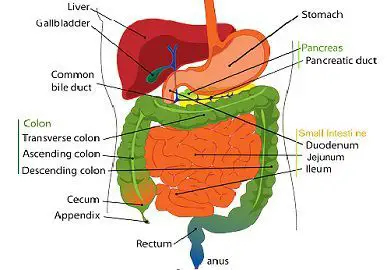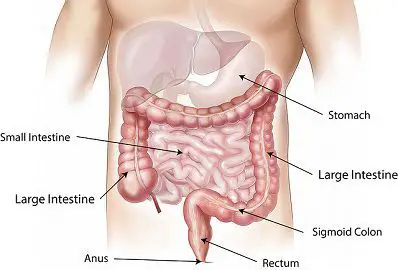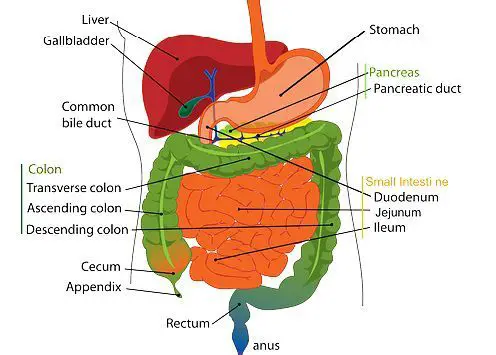The Small intestine also is known as Small Bowel, which is around 20 feet long while Large intestine which is also called colon or Large bowel, is only 1.5 m long in size. Being the part of our digestive system, they differ in their structure as well in their functions too.
The small intestine is called small because of its small diameter which is around 3.4-4.5 cm broad only, as compared to the large intestine, which is 4-6 cm broad.
The primary function of the small intestine is to absorb or take in nutrients from the digested food while large intestine absorbs salt and water. Large intestine starts from the place where the small intestine ends, while small intestine is present between large intestine and stomach.
Both the tubes are interconnected, as well important components of the digestive system, but they can be differentiated in many ways, in the given article we will be discussing the general differences between small and large intestine.
Content: Small Intestine Vs Large Intestine
Comparison Chart
| Basis for comparison | Small Intestine | Large Intestine |
|---|---|---|
| Size | Small intestine measures around 4.5 - 7.0 m in size. | Large intestine measures around 1.5 m in size. |
| It is narrow in width of around 3.5 - 4.5 cm. | It has width of around 4 - 6 cm in diameter. | |
| Parts | It has three parts, which are duodenum, jejunum and ileum. | It has four parts, which are colon, rectum, caecum and anal canal. |
| Circular folds | Internal surface of small intestine has circular folds, also called as 'palicae circulares'. | Circular folds are absent. |
| Presence of Villi | Villi are present. | Villi are absent. |
| Peyers Patches | Peyers Patches are present. (aggregations of lymphoid tissue). | Peyers patches are absent. |
| Muscle bands | It forms the layer of continuous bands of muscles around it. | It is reduced to three types of muscles bands called as taeniae coli. |
| Taeniae Coli | Taenia coli is absent from the surface of small intestine. | Taenia Coli are present. |
| Motility | It shows small movements in the abdominal cavity . | Large intestine is fixed or show very little mobility. |
| Hastura | Absent | Present |
| Epiploic appendages | Epipolic apppedages is absent in small intestine. | Epipolic appendages are present. |
| Role in digestion | Digestion is complicated. | No role in digestion. |
| Hormones Secreted | Numerous hormones are secreted. | No hormones are secreted. |
| Activity | It absorb the nutrients from the digested food. | It takes part in absorption of water and electrolytes and in production of vitamins. |
| It shows small movements in abdominal activity. | It has less mobility and is largely fixed. |
Definition of Small Intestine
The small intestine has the narrowest diameter of all the parts of the alimentary canal, though it is the longest one which measures around 4.5 to 7 m in the length. It is located between large intestine and stomach. This tube kind of structure is coiled in the abdomen. Internally it has two in growths, circular folds or palicae circulares and villi (microscopic finger-like projection).
These villi help in increasing the surface area for absorbing the maximum nutrients available. In this part, the food remains for a longer duration for the purpose of digestion and absorption, as due to the presence of circular folds, the movement of food slows down through the intestine.
The small intestine is divided into three parts which are duodenum, jejunum, and ileum. Duodenum starts from the end of the stomach, it has a small opening through biliary system and pancreas which helps in breaking down of proteins and fats, as well allows digestive secretion to flow into it. Duodenum is considered as smallest part among the three. The middle part of small intestine is the jejunum.
The villi absorb all the digested products, present in the jejunum. The ileum is the third and last part of small intestine, which ends into the large intestine, it helps in absorbing the remaining nutrients, vitamins (especially B12 ) and bile salts.
Definition of Large Intestine
The Large intestine has the wider diameter of around 4-6 cm and hence called large intestine. The length ranges around 1.5 m. The Large intestine is the hindermost part of the alimentary canal and opens outside through anus.
The Large intestine is also called as colon or large bowel. It starts from the place where the small intestine ends. It has four regions rectum, colon, caecum, and anal canal. The Large intestine has smooth muscles, which contract and relax the work until the food gets out through the anus.
Colon consists of four parts namely ascending colon, transverse colon, descending colon and sigmoid colon. It absorbs water and salts from the digested products and stores remaining product as feces. As large intestine does not contain villi, it does not have the capacity to absorb nutrients. Caecum has an attachment to a vestigial organ called as ‘Appendix’.
Microflora (benign bacteria) which is present in the large intestine, helps in the production of vitamins such as vitamin B2, vitamin B1, vitamin K, vitamin B12. The Large intestine has taeniae Coli, which are the longitudinal muscles, it starts from the appendix base and extends up to the rectum. Bulges kind of structure is also present called as hastura, which are the contraction of taeniae coli.
Key Difference Between Small Intestine and Large Intestine
Though both are the interconnected and important parts of the digestive system, they differ in their functions and structure, following are the key differences between the both:
- The small intestine is 4.5-7.0 m in size long, but is narrow in width of around 3.5-4.5 cm only, whereas Large intestine measures around 1.5 m in size in length and width of 4-6 cm in diameter, and due to this broadness difference in the tubes of the large intestine and small intestine, they are named accordingly.
- Small intestine is divided three parts, which are duodenum, jejunum and ileum which helps in absorption of nutrients from the digested food, while Large intestine has four parts, which are colon, rectum, caecum and anal canal which helps in absorption of water and electrolytes, as well in production of vitamins like B and K with removing of waste material.
- Circular folds also called as ‘palicae circulares’ as present in the internal surface of the small intestine, whereas it is absent in large intestine.
- The presence of Villi is what makes small intestine different from the large intestine, as villi are the important constituents which are helpful in absorbing nutrients from the food. This function is absent in large intestine and thus capable of absorbing water and electrolyte and iron.
- Peyers Patches which are the aggregations of lymphoid tissue present on the mucous membrane of the small intestine, while it is absent in large intestine.
- Taenia Coli and Hastura is absent from the surface of the small intestine, whereas they are present in the large intestine.
- Small intestine shows small movements in the abdominal cavity whereas Large intestine is fixed or show very little mobility.
- Digestion is complicated in the small intestine; large intestine has no role in digestion rather it helps in absorption of water and electrolytes.
- Numerous hormones are secreted by small intestine; No hormones are secreted by the large intestine.
- Small intestine forms the layer of continuous bands of muscles around it, while Large intestine is reduced to three types of muscles bands called as taeniae coli.
- Epiploic appendages (fatty tags) is absent in small intestine; This appendages are present in the large intestine.
- The main activity of small intestine is to absorb the digested nutrients and it also shows small movements in abdominal activity, and the main function of the large intestine is in the absorption of water and electrolytes as well it shows less mobility and is largely fixed.
Conclusion
The long-running tubes right from the stomach to the anus is called intestine. Their main function is to absorb the nutrients, water, and electrolytes from the food. The intestine is divided into the small intestine, long intestine, and rectum. These are the main parts of the digestive system, as the main function i.e. absorption of nutrients takes place here along with defecation process from the food we eat.
So we can say that these tubes are the kind of appendages plays very important role in the digestion of food, in absorbing the important nutrient, electrolytes as well water and also in eliminating the waste products. Though both differ in their function as well as in structure but works coordinately to keep the body fit and functional.




Meenakshi negi says
Good information in simple words………..
myango says
its helpfull thank you!
bhvik says
GOOD INFORMATION ABOUT SMALL AND LARGE INTESTINE
Salama n salama says
Thank you